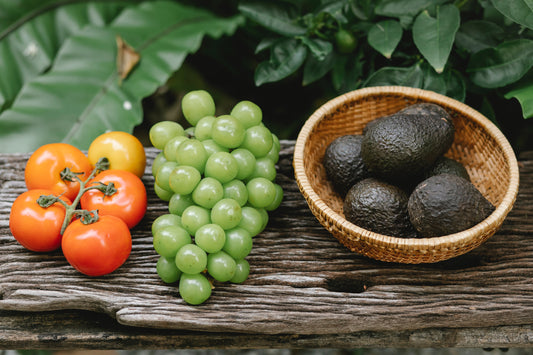If you’ve ever gotten a hankering for something sweet and decided that you needed to bake something to satisfy that craving, you’ve almost definitely used vanilla extract before. It’s a staple ingredient in nearly every dessert recipe you’ll ever make, and its smooth, buttery-sweet taste brings out the decadent flavors of many of our favorite treats. But when you head to the grocery store to pick up a bottle for those cookies, cakes, and desserts, you’re faced with two different options: real vanilla extract or imitation vanilla. Your gut instinct might be to reach for the real vanilla, plus many recipes urge you to go for the real stuff and not imitation. But that high price on the bottle of pure vanilla extract might give you pause and make you consider using imitation vanilla instead. So what’s really the deal between real vs. imitation vanilla, and is one better than the other? (Spoiler alert: not really, they both have their uses in cooking and baking!)
What is vanilla?

Real vanilla comes from the beans of vanilla orchids. There are a couple of different types of vanilla orchids found in various countries around the world, and each resulting bean has a slightly different flavor with woody, floral, or spicy notes. Some of the most common vanilla bean variations include:
- Madagascar Bourbon Vanilla Beans
- Mexican Vanilla Beans
- Indonesian Vanilla Beans
- Tahitian Vanilla Beans
The beans (or “pods”) are picked from the orchids then matured, dried, and processed into different vanilla products that you can buy. You can find vanilla in its pure form as a dried bean, or in a vanilla bean paste. However, many recipes will call for pure vanilla extract, a liquid version of vanilla that is made from soaking vanilla beans in alcohol and water. That sweet, smooth vanilla taste that you know and love primarily comes from vanillin, a chemical that is naturally found in vanilla beans. But there are also several other chemical compounds found in vanilla beans that contribute to their rich, warm, creamy flavor.
What is imitation vanilla?
Imitation vanilla is often also referred to as “vanilla essence.” It also gets its flavoring from vanillin, the same chemical responsible for the rich flavor of natural vanilla beans. But unlike real vanilla beans, the vanillin in imitation vanilla is made artificially in a lab using other sources. Some
common ingredients used to synthesize vanillin include spruce tree lignin, corn sugar, rice bran, clove oil, and petroleum. As opposed to real vanilla, imitation vanilla generally only comes in liquid form, similar to vanilla extract.
Pure Vanilla Extract vs. Imitation Vanilla
So how does imitation vanilla size up to the real deal?
Cost
One of the first things you’ll notice when comparing pure vs. imitation vanilla extract is the steep price difference. Pure vanilla comes at a much higher price point than imitation vanilla. This is because the harvesting of vanilla from vanilla orchids is highly labor-intensive and largely done by hand, which leads to those exorbitant prices. This means that imitation vanilla tends to be much cheaper and much more readily available than pure vanilla extract. In fact, it’s estimated that up to 99% of vanilla products out there are actually imitation, not pure vanilla!
Processing
There’s also the issue of sourcing. Some people may have an issue with the idea of imitation vanilla because it is synthetic, meaning that it’s made in a lab as opposed to extracted from a real plant. In an era where we’re more concerned about the health and quality of the foods that we eat, many consumers prefer to buy ingredients that are less processed and “all-natural,” making pure vanilla extract generally more desirable than imitation. But semantics aside, it’s important to note that “chemicals” are not necessarily a bad thing. Remember, the resulting vanillin compound that is made for imitation vanilla is the exact same chemical that you would find in a real vanilla bean!
Taste
Finally, let’s get down to the real deciding factor: taste quality. Yes, real vanilla beans have a much more complex flavor than vanillin. After all, vanillin alone isn’t the only flavoring agent in vanilla beans, just the most prominent. But like many natural compounds, those other complex flavors that are found in pure vanilla extract can start to degrade when exposed to high temperatures -- which, unfortunately, is what baking is all about. It’s also important to note the other ingredients that are found in each kind of extract. Pure vanilla has to have at least 35% alcohol as regulated by the U.S. Food and Drug Administration, whereas imitation vanilla extract does not require this. Therefore, some pure vanilla extracts may have a more alcoholic taste than imitation vanilla. So the best way to really decide which type of vanilla is superior is through taste tests, and surprisingly, many of them rule in favor of the imitation kind. For example, taste tests conducted by
Cooks Illustrated and
Epicurious both found that the difference in taste in baked goods was subtle or even undetectable, but made with imitation vanilla extracts tended to win over desserts made with pure vanilla extract. This is probably due to the stronger vanilla flavoring in imitation vanilla that can stand up to high heat in baking.
When To Use Real Vanilla vs. Imitation Vanilla
So is there an appropriate time to use real vanilla extract rather than imitation vanilla (and vice versa)? Ultimately, the choice between real vanilla vs. imitation vanilla is up to you, your wallet, and your preferences. But if you have a choice between the two, you can make a decision based on the kind of treat you’re making:
- The best uses for the extract from real vanilla beans are in lighter, more delicate items that aren’t cooked at super-high temperatures. So things like ice cream, frostings, puddings, custards, and creme brulee will really sing with the complex and nuanced flavor of real vanilla beans.
- But if you want really flavorful cookies, cakes, breads, and other baked goods that require high heat in the oven, you may do better with the more strong, stable flavors of imitation vanilla instead.
Whichever type of liquid vanilla product you choose, they are similar enough that you can use a 1:1 ratio.
Conclusion
Like flour, sugar, butter, and eggs, vanilla extract is a staple in any baker’s pantry, and it turns out that you don’t need to spend big bucks on the real deal to result in a tasty treat. Pure vanilla extract tends to have more complex flavors, but those flavors can degrade at high temperatures. Meanwhile, imitation vanilla extract doesn’t have as nuanced of a flavor profile as real vanilla, but its strong synthesized vanillin flavoring can hold up in baked goods like cookies and cakes. Ultimately, both kinds of vanilla can be used successfully to make your favorite sweet treats!
Image credits: Featured image: Photo by
Monserrat Soldú from
Pexels image 1: Photo by
Jocelyn Morales on
Unsplash
 Real vanilla comes from the beans of vanilla orchids. There are a couple of different types of vanilla orchids found in various countries around the world, and each resulting bean has a slightly different flavor with woody, floral, or spicy notes. Some of the most common vanilla bean variations include:
Real vanilla comes from the beans of vanilla orchids. There are a couple of different types of vanilla orchids found in various countries around the world, and each resulting bean has a slightly different flavor with woody, floral, or spicy notes. Some of the most common vanilla bean variations include:






